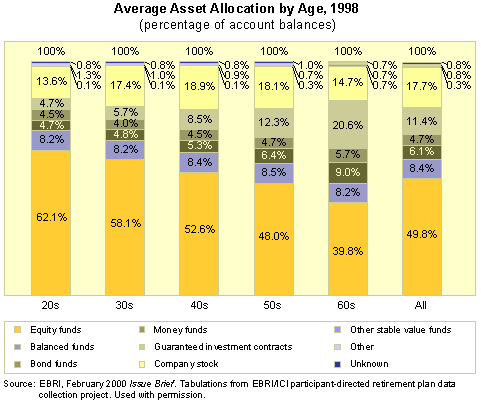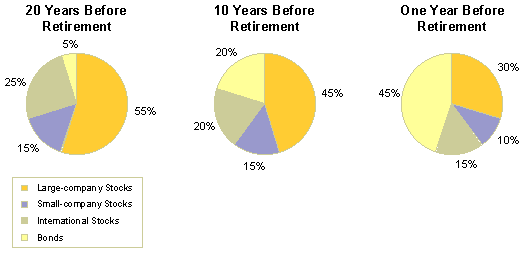|
The Value of Asset AllocationIf you are contributing to a 401k plan, you are no doubt aware of the capitalist credo, "it takes money to make money." Yet, in a market that can rise just as soon as fall; a market subject to emotions and global shifts, that same credo might be better written, "it takes wisely invested money to make money." Divvying up your investments among different asset classes is called asset allocation. The best way to think about it: "Asset allocation is really a risk reduction strategy," said Michael Horwitz, a certified financial planner with Austin Asset Management. It is one of the most important, and often least planned out, aspects of saving in a 401k. An asset allocation strategy can be applied to investment inside and outside of your 401k. This article deals strictly with asset allocation within your 401k. By allocating your assets according to your risk tolerance, years to retirement and the financial needs you foresee yourself having in retirement, you can reduce the risk of not achieving the retirement lifestyle you've imagined for yourself. In this, the first of our exclusive three-part series on asset allocation, we will cover the basics of allocation. Subsequent articles will deal with rebalancing your 401k and 401k day traders. Wake Up and Start DreamingAn indispensable step in proper asset allocation is simply deciding what you want your retirement to be like, and what expenses that will entail. You probably have a dream that puts a smile on your face -- whether it be sailing around the world or building furniture. But, don't forget day-to-day expenses, or unforeseen costs like health care. Indeed, savers who know how much they need for retirement generally have five times more money in their 401k plans than people who don't know, according to the Employee Benefit Research Institute (EBRI) 1999 Retirement Confidence Survey.
Taking the time to think about living arrangements, monthly bills, food, and entertainment expenditures can help you define what kind of financial shape you need to be in when you reach retirement. Your Risk ThresholdAfter nailing down a realistic picture of your retirement, you can decide the extent of the financial chances you are willing to take to fulfill those dreams. This is called risk tolerance. Assessing your tolerance for risk can be thought of as figuring out how willing you are to accept drops in value in your 401k account. More volatile investments, such as high-tech equities or high-yield ("junk") bonds, carry with them not only a greater chance for gain but a greater chance for loss, than, say, more stable investments like short-term bonds or blue-chip stocks. Think about your current and past money habits, if you have no investment history, to determine how you deal with risk. Do you accept loss well, or do money issues make the veins in your forehead pop out? Are you willing to ride out the storm of a down market? From 1926 to 1999, the stock market, as measured by the Dow Jones Industrial Average, recorded 23 down years. That's nearly one out of three years. You need to determine if you can deal with those down years without selling your investments at a loss. In thinking about risk, "we are dealing with human behavior," said Horwitz. "... if a client is going to overreact to a negative return in their portfolio by switching from equities to cash, in a sense undoing their plan, that has to be taken into account." Remember, you only lose money if you actually sell the stocks when they're down, rather than holding on to them until they go back up. Risk can also come into play if you are not on track to meet your retirement goals. If, for example, you have five years until retirement, and are not financially prepared, you may have to take on more risk than you are comfortable with to achieve your goals. Below are three charts showing how you can change the level of risk in your portfolio by adjusting your equity holdings (bonds generally being a less risky investment).
Investment ChoicesWith a clear goal in mind and a feel for your level of tolerable risk, it's time to acquaint yourself with your investment options. Don't shy away from researching your fund choices; it will pay off in the end. "There is no substitute for looking at readily available reports (on your 401k investment choices)," said Horwitz. Researching a fund, depending upon how in depth you want to go, can be a multi-layered and time-consuming process. In general, financial planners suggest that you review investment policy, managerial style, and historical performance, at the very least. Another very important thing to research is fund purity. To read more about this, check out an excerpt from our upcoming Wall Street 201 investing course. You can learn a lot about a mutual fund from the prospectus. There are other sources available as well, both online and in print. The investment options most commonly found in 401k plans are stocks, bonds and cash (money market funds). A further delineation can be made between large-capitalization (large-cap) stocks, middle capitalization (mid-cap), small capitalization (small-cap) stocks and international stocks. These may be divided into "value" stock funds and "growth" stock funds. Here is a quick look at the most common 401k investment options. Large-cap Stock Funds: Large-cap stock funds generally have a median market capitalization of more than $5 billion to $10 billion. These stock funds are made up of large companies, like GE. Mid-cap Stock Funds: Mid-cap stock funds normally have a median market capitalization of between $2 billion and $10 billion. Small-cap Stock Funds: Small-cap stock funds typically have a median market capitalization of less than $2 billion. International Stock Funds: International stock funds invest in equity securities of issuers located outside of the United States. Global Stock Funds: This type of mutual fund generally includes at least 25 percent foreign securities in its portfolio. Bond Funds: Bonds are usually divided between longer maturity and shorter maturity. Short-term bonds are generally considered to be less risky than long-term bonds. A bond fund is always replacing bonds in its portfolio to maintain its average maturity objective. You may also have a foreign bond option. Stable Value Funds: These funds can provide an attractive alternative to bond funds or money market funds in a 401k plan. These funds invest in stable value contracts with insurance companies or banks, and their market risk is generally less than that of a stock or bond fund. Money Market Funds: Sometimes referred to as "cash," money market funds are like bank savings accounts in that the value of your original investment does not fluctuate. However, they are not guaranteed like a bank savings account would be, and the interest rate is generally lower than for stock and bond funds. Index Funds: These funds are invested to replicate an existing market index such as the S&P 500, which is an index of 500 large U.S. company stocks. Company Stock Funds: These funds allow you to invest in the company you work for. Company stock funds are not diversified investments, which makes them theoretically more volatile than a mutual fund. Emerging Market Funds: These funds are made up of stock of companies located in developing nations. Life Cycle Funds: A life cycle fund is a mutual fund geared toward investors in a certain age group or with a specific time horizon for investing. Different StrategiesSo, now we come to the rub. Asset allocation comes down to combining the different asset classes in a way that reduces your overall investment risk, and therefore the risk of not achieving your goal. "The question of how much to allocate to each column has been debated for years and there is no simple answer," said Nikki Ross, certified financial planner and author of Lessons from the Legends of Wall Street: How Warren Buffet, Benjamin Graham, Phil Fisher, T. Rowe Price and John Templeton Can Help You Grow Rich. Some financial planners recommend that their clients invest 70 percent of assets in stocks and 30 percent in bonds. Some suggest an 80-20 split. Some want their clients to invest 100 percent in equities. Every situation is different and demands a unique, investor-specific strategy.
When deciding on how to divide up your 401k investment, you have to ask yourself some questions: How long do you have until retirement? What rate of return will allow you to achieve your retirement goals? What level of risk are you comfortable with? And, how much can you invest annually? Generally, the longer you have to retirement, the longer you have to weather market downturns and the more aggressive you can be. As you move toward retirement, many financial planners suggest that you move at least some of your money into more conservative investments. However, if you are planning to be retired for a number of years, you will need to keep some of your portfolio in aggressive investments, to outpace inflation. It's a long-term strategy. "If you have a high savings rate and can save 15 percent of salary through (a) 401k, and diversify, there's no question you will attain a high level of wealth over a 20-year period," said Horwitz. So, asset allocation allows for a trade-off of substantial risk for a better probability of achieving your financial goals. Asset allocation may not produce the best return-on-investment you can achieve, but that's not the goal. The goal, through diversifying, is to minimizing your risk and keep you from having to guess about what will be hot and what won't in the market. "When you do asset allocation, you are taking the crystal ball and throwing it in the closet," said Scott Leonard, CFP and owner of Leonard Capital Management. This is for educational purposes only. The information provided here is intended to help you understand the general issue and does not constitute any tax, investment or legal advice. Consult your financial, tax or legal advisor regarding your own unique situation and your company's benefits representative for rules specific to your plan. Read also: Asset Allocation Made Simple, Boost Your 401k Returns by Rebalancing, and Nurture Your 401k Portfolio Using Asset Allocation. This is for educational purposes only. The information provided here is intended to help you understand the general issue and does not constitute any tax, investment or legal advice. Consult your financial, tax or legal advisor regarding your own unique situation and your company's benefits representative for rules specific to your plan. |
|
About
| Glossary
| Privacy Policy
| Terms of Use
| Contact Us
|



